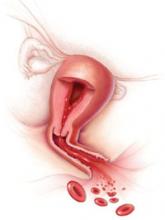- The levonorgestrel-IUS is the most effective treatment for heavy menstrual bleeding, reducing blood loss by close to 100% (A).
- Endometrial ablation is an effective treatment for women who want to avoid major surgery and preserve their uterus, but have no wish to become pregnant in the future (A).
- Endometrial biopsy should be part of the evaluation of abnormal uterine bleeding in all women over age 35 (B).
Strength of recommendation (SOR)
A. Good-quality patient-oriented evidence
B. Inconsistent or limited-quality patient-oriented evidence
C. Consensus, usual practice, opinion, disease-oriented evidence, case series
Ms. M, a 39-year-old mother of 3, runs a busy day-care center, cares for her sick mother, and shuttles her children among their myriad activities. During today’s office visit, she seems anxious. She says her periods are regular, but have become increasingly heavy in recent years and may last as long as 9 days. The bleeding is very heavy, with a lot of clots and some cramps during the first few days. In the past year, painful periods have caused her to miss work on several occasions. She says she often feels tired, and worries that she may be anemic. Preserving fertility is not a concern; her husband has had a vasectomy.
On exam she is without orthostasis and appears well. Her uterus is top-normal size, nontender, and there are no adnexal masses or cervical or vaginal abnormalities. You note a normal Pap at your office 5 months ago. Her office hemoglobin is 9.8 mg/dL.
She asks you to refer her to a gynecologist for a hysterectomy because she “just can’t take it anymore.” Her heavy menses are disrupting her life. Since she does not want any more children, she feels that if someone could “just take it out,” her problem would be solved. But she isn’t really enthusiastic about a hysterectomy because her life is too busy to allow time for a lengthy recovery.
You explain that there are a number of options you’d like her to consider first. Then you review the options and some of the research behind them, having recently read an article on evidence-based therapy for abnormal uterine bleeding.
A common complaint in primary care
Abnormal uterine bleeding is a common reason for women to visit their primary care clinician, accounting for about 20% of gynecologic primary care visits.1 Women are understandably concerned about any disruption of their normal bleeding pattern. Many, however, are unaware of common causes of abnormal bleeding and available treatment options.
Most cases of chronic abnormal bleeding can be classified as either heavy and regular (menorrhagia) or heavy and irregular (menometrorrhagia). A rule of thumb to help guide diagnostic testing is that menorrhagia often results from anatomic problems of the uterus or endometrium, such as polyps. Menometrorrhagia is more likely to result from hormonal abnormalities, such as polycystic ovarian syndrome (PCOS). This review will focus on medical and minimally invasive surgical therapy for chronic abnormal bleeding.
First step: Pregnancy test
Many conditions can cause abnormal uterine bleeding (TABLE 1). In women of reproductive age, the first step in the diagnostic process should be a urine or serum pregnancy test. Urine pregnancy tests have a sensitivity of 90% one day after a missed period and approximately 97% after one week.2 In addition to a pregnancy test, consider testing for thyroid dysfunction and obtaining serum prolactin levels for women presenting with anovulatory bleeding.3 If anemia is suspected, a hematocrit or hemogram is indicated. All patients over the age of 35 who present with abnormal uterine bleeding should have an office endometrial biopsy to rule out endometrial hyperplasia or cancer.4
Is she ovulating? Most cases of heavy bleeding with irregular periods are the result of anovulation, which is common soon after menarche and at the approach of menopause. Other causes of anovulatory bleeding include PCOS, hypothyroidism, and elevated prolactin levels. Chronic, irregular bleeding without a known anatomic cause is termed “dysfunctional uterine bleeding,” or DUB.5
Are periods regular? Heavy bleeding with a regular menstrual cycle (ovulatory bleeding) usually has a different etiology. It most often occurs because of anatomic abnormalities such as endometrial polyps, fibroids, and adenomyosis (pockets of endometrium found within the uterine myometrium). Heavy menstrual bleeding that occurs at the onset of or shortly after menarche may be due to a coagulopathy, such as von Willebrand disease. Therefore, consider platelet function analysis for adolescents who present with heavy menses, particularly if they require blood transfusion.


